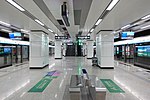Beijing Liao and Jin City Wall Museum
1995 establishments in ChinaHistory museums in ChinaMajor National Historical and Cultural Sites in BeijingMuseums in Beijing

The Beijing Liao and Jin Dynasty City Wall Museum (Chinese: 北京辽金城垣博物馆) is a museum built over the ruins of Beijing's Liao and Jin dynasty (1115–1234) city wall. The museum is located at No.41 Yulinli, Yulin South Road, in Fengtai District of southwestern Beijing, near the north bank of the Liangshui River.
Excerpt from the Wikipedia article Beijing Liao and Jin City Wall Museum (License: CC BY-SA 3.0, Authors, Images).Beijing Liao and Jin City Wall Museum
Fengtai District Youanmen (You'anmen)
Geographical coordinates (GPS) Address Nearby Places Show on map
Geographical coordinates (GPS)
| Latitude | Longitude |
|---|---|
| N 39.861388888889 ° | E 116.35263888889 ° |
Address
100069 Fengtai District, Youanmen (You'anmen)
Beijing, China
Open on Google Maps










